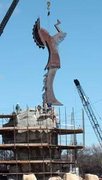Wednesday, February 28, 2007
Turbulence
Chinese stocks fell almost 9% in Shanghai overnight Tuesday. The Dow responded by dropping over 500 points as part of a world wide rout in share prices.
Among the economic news, there was plenty to make investors revise their expectations.
Alan Greenspan suggested there might be a recession in our future. (See below.)
GDP growth
The estimated growth of the U.S. economy was revised downward. The Commerce Department said GDP grew only 2.2 percent (that is a seasonally adjusted annual rate) far short of the 3.5 percent initially reported. That is one of the largest downward revisions in a long time. The main culprit was the estimate of inventory investment, although downward revisions of fixed business investment spending and consumer spending on durable goods and nondurable goods all contributed.
The fourth quarter saw a big inventory sell off. Although this pulled down estimated GDP growth by 1.35 percentage points (final sales grew 3.6 percent), a drop in inventories can be a good omen for future production. We must take a careful look at its composition.
New home sales dropped 16.6 percent in January.
The housing sector is continuing to worry investors. They are right to worry. The lenders who financed the run-up in house prices are now finding their capital strained. See Justin Lahart: "After Subprime: Lax Lending Lurks Elsewhere" and Robin Sidel And David Reilly, "No Worries: Banks Keeping Less Money in Reserve."
The fallout
Viewed from the vantage point of Thursday afternoon, investors seem to have taken Professor Greenspan’s advice. They are now a bit more risk adverse. Consequently stocks are a bit cheaper, government bonds a bit dearer, and high yield bonds’ yields are higher. And analysts are now a bit gun shy about saying the economy has nowhere to go but up.
Monday, February 26, 2007
"We have extraordinarily low risk premiums now."
He found "disturbing" how low risk premia have fallen. Professor Greenspan was teaching us that when we discount risk too much we set ourselves up for a fall. When shocks occur, investors and institutions become more risk averse in reaction. This sets up the pull back in lending, investing, and spending that drives the economy down.
Friday, February 02, 2007
Is the News That the Employment Report Was Weak or that BLS Found another Million Jobs?
The Labor Department's January employment report came out today. Economists' reactions were all over the map. And well they should be.
When the Bureau of Labor (BLS) asked firms how many people were on their payrolls, the results indicated that jobs grew by a fairly modest 111,000 in January. When its surveyors phoned households, they found that 4.6 percent of the workforce said they were unemployed, up from December's 4.5 percent.
Conclusion: based on those bare facts, the economy is growing but somewhat weakly. Hence the Wall Street Journal's headline: "Heading for a Soft Landing."
But you need to read the fine print to get the real shock! The statisticians on Massachusetts Avenue rebenchmarked their samples to an actual count of firms who are registered with the state employment offices.
Guess what?
There were 981,000 more jobs in December than BLS had estimated in its previous report. The monthly data were revised back almost two years. (The revision is "only" 933,000 on a seasonally adjusted basis.)
This means that the year over year employment growth in December was 1.66 percent. A month ago, we thought employment had grown only 1.37 percent. Apparently the economy was stronger than the 2006 data initially led us to believe. On Wednesday we got a surprise. The Commerce Department reported the Gross Domestic Product grew a strong 3.5 percent at a seasonally adjusted annual rate in the last quarter. In light of these revisions, it should not have been such a surprise.
Fed watchers should note that the economists who work for Dr. Bernake also read footnotes!
What is a Forecaster to Do?
This episode gives you a little insight into the real difficulties of business forecasting.
Consider the Postal Service which not only has one of the most sophisticated business forecasting systems in the world, but also shares it with the public through its rate filings. When you read the testimony of Thomas E. Thress one of the Postal Service's experts with RCF Consulting, you will find that a similar measure of employment in the forecasting equation for First-Class single piece mail. One of the attractions of this variable in forecasting and econometric work is its robustness against revision and statistical reporting quirks by the reporting agency (BLS.)
Unfortunately, the gnomes in the bowels of BLS are not cooperating.
